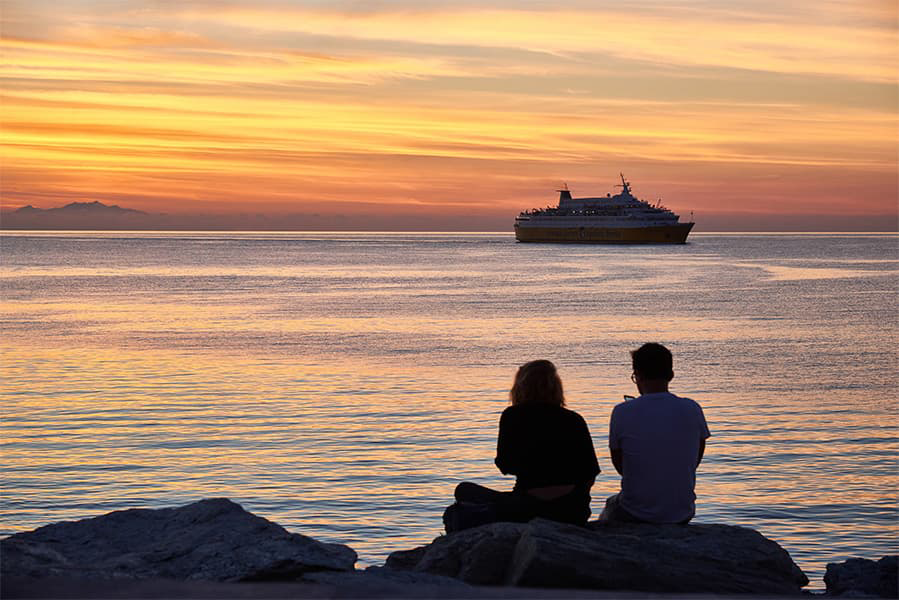Huelva - Santa Cruz de Tenerife
Ferries to Tenerife
Huelva - Santa Cruz de Tenerife
Ferries to Tenerife

Fred Olsen Express provides the ferry from Huelva to Santa Cruz de Tenerife. Huelva Santa Cruz de Tenerife ferries cost around $363 and $2643, depending on ticket details. Prices exclude any service fees. Ferry schedules change seasonally, use our Deal Finder to get the latest ferry ticket information for Huelva Santa Cruz de Tenerife ferries.
Huelva Santa Cruz de Tenerife ferry sailings typycally depart from Huelva at around 06:00. The last ferry leaves at 23:59.
The Huelva Santa Cruz de Tenerife ferry trip can take around 39 hours. The fastest Huelva to Santa Cruz de Tenerife ferry is around 32 hours. Crossing times can vary between ferry operator and seasons.
There are around 3 weekly sailings from Huelva to Santa Cruz de Tenerife serviced by Fred Olsen Express. Timetables can vary by season and operator.
Huelva Santa Cruz de Tenerife ferry prices typically range between $363* and $2643*. The average price is typically $1005*. The cheapest ferries from Huelva to Santa Cruz de Tenerife start from $363*. The average price for a foot passenger is $345*. The average price for a car is $981*.
Ferry price can vary based on booking factors such as number of passengers, vehicle type sailing times. Pricing is taken from searches over last 30 days and exclusive of service fees, last updated December 25.
The distance between Huelva to Santa Cruz de Tenerife is approximately 874 miles (1407km) or 760 nautical miles.
Yes, Fred Olsen Express allow cars on board ferries between Huelva and Santa Cruz de Tenerife. Use our Deal Finder to get live pricing for car ferries between Huelva and Santa Cruz de Tenerife.
Foot passengers can travel on the Huelva to Santa Cruz de Tenerife ferry with Fred Olsen Express.
Pets can travel on ferries from Huelva to Santa Cruz de Tenerife with Fred Olsen Express. Pets may have to stay in the vehicle during the journey depending on the operators guidelines.
More routes than anyone else.

Compare fares, times & routes in one place.
Change plans easily with flexi tickets.

Book e-tickets & manage trips in-app.
Live ship tracking & real-time updates.

Top-rated customer support when you need it.
| Huelva - Santa Cruz de Tenerife Ferry Route Summary | ||
|---|---|---|
| Departure Country | Spain | |
| Destination Country | Tenerife | |
| No. of Operators | 1 | |
| Operators | Fred Olsen Express | |
| Average Price | $1005 | |
| Average Daily Sailings | 1 | |
| Average Weekly Sailings | 3 | |
| Average Sailing Duration | 39 h | |
| Fastest Sailing Duration | 32 h | |
| First Ferry | 06:00 | |
| Last Ferry | 23:59 | |
| Distance | 760 Nautical Miles | |
* Prices subject to change, pricing is taken from last 30 days, last updated 1 December 2025.
The Spanish city of Huelva is the capital of the province of Huelva in the autonomous region of Andalusia in the south west of Spain. The city, and its port, lies on the Gulf of Cadiz, where the River Odiel and River Tinto meet. The city's long history dates back to around 3,000 BC and many Roman artefacts have been uncovered in the city which bears testament to the Roman mint that was once located in the city.
Visitors to Huelva will find many things to do and see in the city and the surrounding area. There are a number of sites that have an association with the explorer Christopher Columbus which include Moguer, Palos de la Frontera and the Rabida Monastery. In addition to these sites there are fine examples of Baroque architecture to be found in the Condado part of the city. One of the highlights of the city's cultural calendar is the Pilgrimage of el Rocio, which has been declared of International Tourist Interest.
The ferry port at Huelva is located in the Exterior Port and is accessible via a free bus service that takes travellers from the port to Huelva city centre on arrival and from the city centre to the port for departures.
Santa Cruz de Tenerife is a port city located on the Spanish island of Tenerife, the largest of the Canary Islands. The city has an important port and is filled with wide streets, beautiful landscaped areas and some fine examples of modern architecture. The city can trace its back around 400 years when the city began to develop in the late 16th century aided by its port which enabled to city to become the second most populated city in the Canary Islands. The centre of the city sits on the site of the former fortress of San Cristobal and is looked over by the monument dedicated to the Triumph of Candelaria, which is a neoclassical sculpture in Carrara marble and was created by the Italian Pasquale Bocciardo. This part of the city is also overlooked by the 18th century Baroque facade of the La Carta Palace. In the centre of the city, near the sea, several of the busiest streets and squares of the capital meet, such as the Plaza de la Candelaria.
From the city's port there are ferry services departing to mainland Spain and to the other Canary Islands.